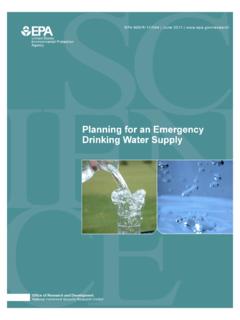Transcription of Minimum Standards in Water Supply, Sanitation …
1 Minimum Standards in Water supply , Sanitation and hygiene PromotionHumanitarian Charter and Minimum Standards in Humanitarian Response80 How to use this chapter This chapter is divided into seven main sections: Water supply , Sanitation and hygiene promotion (WASH) hygiene promotionWater supplyExcreta disposalVector controlSolid waste managementDrainageThe Protection Principles and Core Standards must be used consistently with this chapter Although primarily intended to inform humanitarian response to a disaster, the Minimum Standards may also be considered during disaster preparedness and the transition to recovery activities Each section contains the following: Minimum Standards : These are qualitative in nature and specify the Minimum levels to be attained in humanitarian response regarding the provision of Water , Sanitation and hygiene promotion Key actions: These are suggested activities and inputs to help meet the Standards Key indicators: These are signals that show whether a standard has been attained They provide a way of measuring and communicating the processes and results of key actions.
2 They relate to the Minimum standard, not to the key action Guidance notes: These include specific points to consider when applying the Minimum stan-dards, key actions and key indicators in different situations They provide guidance on tackling practical difficulties, benchmarks or advice on priority issues They may also include critical issues relating to the Standards , actions or indicators, and describe dilemmas, controversies or gaps in current knowledge If the required key indicators and actions cannot be met, the resulting adverse implications for the affected population should be appraised and appropriate mitigating actions taken A needs assessment checklist is included as Appendix 1; guideline notes are provided in Appendices 2 6.
3 And a select list of references and further reading, which points to sources of information on both specific and general issues relating to this chapter, is also provided Minimum Standards in Water supply , S anitation and hygiene P romotion81 ContentsIntroduction 831 Water supply , Sanitation and hygiene promotion (WASH) 882 hygiene promotion 913 Water supply 974 Excreta disposal 1055 Vector control 1116 Solid waste management
4 1177 D r a i n a g e 121 Appendix 1: Water supply , Sanitation and hygiene promotion initial needs assessment checklist 124 Appendix 2: Minimum Water quantities for institutions and other uses 129 Appendix 3: Minimum numbers of toilets at public places and institutions in disaster situations 130 Appendix 4: Water - and excreta-related diseases and transmission mechanisms 131 Appendix 5: Minimum hygiene , Sanitation and isolation activities for cholera treatment centres (CTCs) 132 Appendix 6.
5 Household Water treatment and storage decision tree 13 3 References and further reading 13 4 Humanitarian Charter and Minimum Standards in Humanitarian Response82 Water supply , Sanitation and hygiene promotion (WASH)Standard 3 Water facilitiesStandard 3 Chemical control safetyStandard 2 Physical, environ-mental and chemical protection measuresStandard 2 Appropriate and adequate toilet facilitiasStandard 2 Water qualityStandard 2 Identification and use of hygiene itemsStandard 1 WASH programme design and implemen-tationStandard 1 Drainage workStandard1 Collection and disposalStandard 1 Individual and family protectionStandard 1 Environment free from human faecesStandard 1 Access and Water quantityStandard 1 hygiene promotion implemen-tationWASHH ygiene promotionWater supplyExcreta disposalVector controlSolid waste managementDrainageAppendix 1.
6 Water supply , Sanitation and hygiene promotion initial needs assessment checklistAppendix 2: Minimum Water quantities for institutions and other usesAppendix 3: Minimum numbers of toilets at public places and institutions in disaster situationsAppendix 4: Water - and excreta-related diseases and transmission mechanismsAppendix 5: Minimum hygiene , Sanitation and isolation activities for cholera treatment centres (CTCs)Appendix 6: Household Water treatment and storage decision treeReferences and further readingHumanitarian CharterProtection PrinciplesCore StandardsMinimum Standards in Water supply , S anitation and hygiene P romotion83 IntroductionLinks to the Humanitarian Charter and international lawThe Minimum Standards for Water supply , Sanitation and hygiene promotion (WASH) are a practical expression of the shared beliefs and commitments of humanitarian agencies and the common principles, rights and duties governing humanitarian action that are set out in the Humanitarian Charter.
7 Founded on the principle of humanity, and reflected in international law, these principles include the right to life and dignity, the right to protection and security and the right to receive humanitarian assistance on the basis of need. A list of key legal and policy documents that inform the Humanitarian Charter is available for reference in Annex 1 (see page 356), with explanatory comments for humanitarian states are the main duty-bearers with respect to the rights set out above, humanitarian agencies have a responsibility to work with disaster-affected popu-lations in a way that is consistent with these rights. From these general rights flow a number of more specific entitlements. These include the rights to participation, information and non-discrimination that form the basis of the Core Standards , as well the specific rights to Water , Sanitation , food, shelter and health that underpin these and the Minimum Standards in this has the right to Water and Sanitation .
8 This right is recognised in inter-national legal instruments and provides for sufficient, safe, acceptable, physically accessible and affordable Water for personal and domestic uses and accessible Sanitation facilities. An adequate amount of safe Water is necessary to prevent death from dehydration, to reduce the risk of Water -related disease and to provide for consumption, cooking and personal and domestic hygienic requirements. The right to Water and Sanitation is inextricably related to other human rights, including the right to health, the right to housing and the right to adequate food. As such, it is part of the guarantees essential for human survival. States and non-state actors have responsibilities in fulfilling the right to Water and Sanitation .
9 In times of armed conflict, for example, it is prohibited to attack, destroy, remove or render useless drinking Water installations or irrigation Charter and Minimum Standards in Humanitarian Response84 The Minimum Standards in this chapter are not a full expression of the right to Water and Sanitation . However, the Sphere Standards reflect the core content of the right to Water and Sanitation and contribute to the progressive realisation of this right importance of WASH in disastersWater and Sanitation are critical determinants for survival in the initial stages of a disaster. People affected by disasters are generally much more susceptible to illness and death from disease, which to a large extent are related to inadequate Sanitation , inadequate Water supplies and inability to maintain good hygiene .
10 The most significant of these diseases are diarrhoeal and infectious diseases transmitted by the faeco-oral route (see Appendix 4: Water - and excreta-related diseases and transmission mechanisms). Other Water - and Sanitation -related diseases include those carried by vectors associated with solid waste and Water . The term Sanitation , throughout the Sphere Handbook, refers to excreta disposal, vector control, solid waste disposal and main objective of WASH programmes in disasters is to reduce the transmis-sion of faeco-oral diseases and exposure to disease-bearing vectors through the promotion of: good hygiene practices the provision of safe drinking Water the reduction of environmental health risks the conditions that allow people to live with good health, dignity, comfort and securit y.













